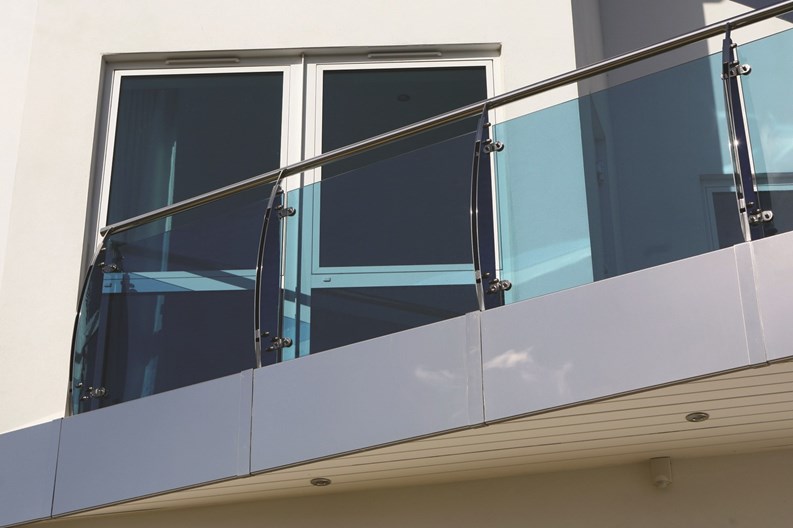Before embarking on a real estate hunt, most prospective buyers craft lists. The “must have” list (square footage, operational plumbing, windows), the “would love list” (lots of natural light, Jacuzzi bathtub, doorman) and then the “probably just a dream” list (heated bathroom floors, private elevator, silent neighbors).
Somewhere on these lists fall balconies and terraces. Both are at a premium in major urban areas like Boston or New York City, and those cosmopolitan residents lucky enough—or wealthy enough—to have a balcony or terrace likely don’t think about the complex structure behind (or rather, under) the square footage that houses their potted plants, lounge chairs and Weber grills. Pleasant and valuable as they are, these small squares of real estate come with their own set of maintenance and safety concerns.
Part of the Whole
It doesn’t take long to find news reports of tragic balcony and terrace accidents. In New York City in 2013, 35-year-old Jennifer Rosoff was killed when the railing on her 16th floor balcony buckled. In 2011, a two-story porch collapsed in Boston’s Jamaica Plain neighborhood resulting in serious injuries to 12 party-goers. In Chicago in 2003, a balcony collapsed during a party, killing 13 people and injuring over 50 more. That accident still stands as the deadliest porch collapse in the United States. These and numerous other tragedies are not meant to scare residents away from enjoying their outdoor space, but they do highlight the importance of regular maintenance and inspections of balconies and terrace areas, as well as the responsible use and upkeep of them by their owners. Even the most well-intentioned building manager may not know how to spot a problem and have it properly diagnosed and remedied—so we turned to some experts and history to help.
Balconies and terraces are built just like buildings (which is to say, out of a mix of steel, concrete and wood) and come in essentially three different construction styles. A cantilevered balcony protrudes directly from the face of a building, seeming to float with no visible supports. Cantilevered balconies are planned and installed as part of a building’s larger design—they can’t be added on after construction is finished. By contrast, a hung balcony consists of a large plate or slab connected to the building, supported and stabilized from above by stainless steel cables. Finally, a stacked balcony (very common in Chicago) requires the least predesign. Stacked balconies are a separate structure from the building, and are supported using vertical pillars sunk into the ground to support the weight of the balcony.
The Massachusetts Building Code governs a number of aspects of balcony construction, including requirements for guards, the use of treated lumber for supports, and the maximum uniformly distributed live load of a balcony.
User Beware
The most common problem affecting balconies and terraces is owner failure. These outdoor spaces can be installed properly, woven into the building structure effectively and efficiently, but they need to be maintained and kept up in order to remain safe. In Berkeley, California in 2015, six people were killed when the balcony they were standing on had “decayed to the point of severe dry rot,” as reported by CNN. According to the report, “A memorandum from inspectors at the Berkeley Building and Safety Division says that the deck’s severed joist ends—horizontal, parallel beams that support a ceiling or floor—looked ‘extensively rotted’ where the structure had ripped from the wall.”
Ralph Noblin, PE, president of Noblin & Associates, LLC, a consulting firm with offices in Bridgewater, Massachusetts and Dover, New Hampshire, has been inspecting building components, including balconies, for more than three decades. He knows that investing in the maintenance of a building’s outdoor space isn’t always the top priority of boards and residents. “Sometimes they know they have a problem,” he says of condo boards. “They can guess at the financial ramifications, and they table it to the next meeting, and then they table it again.”
But, he says, board members “really should defer to the professionals on this issue. It’s about life and safety. Nothing gets more dangerous than an unsafe deck or balcony.”
As a building owner, resident or board manager, you might not be able to eyeball a balcony and gauge whether it is safe and sound, but there are some signs of deterioration you can spot that necessitate calling an inspector. Individual owners should inspect their balconies for cracks, rust, salt stains or discoloration, which are all signs that the metal or wood might be compromised or deteriorating. Take a look at the whole structure, both the roof and the floor, as well as railings and poles. “There are tell-tale signs. You can see rust stains, or concrete falling off,” Noblin says. And, he notes, “When you get into it, it can be a lot worse than it looks on the surface. We’re working on a project now where the structural steel (on balconies) has deteriorated to almost nothing.”
During a recent inspection, Noblin notes, an engineer was walking down a fire escape—a component that is also subject to inspection requirements—and a metal step literally snapped away under his foot. Fortunately, he was holding on to the railing and avoided a fall, but the incident is a reminder of the deterioration that can occur with metal structures.
Signs of deterioration can indicate a number of issues, but primarily point to corrosion due to the age of the building materials used. Especially near the ocean, salt can enter concrete and create an acidic situation, causing corrosion, the same way your car would corrode. “People will think that because their balconies are concrete, they don’t have to worry,” Noblin says. “But even concrete doesn’t last forever.”
Jeanne Allen, AIA, principal at Kipcon New England, LLC, says that owners and managers should keep an eye out for cracking or spalling—broken, flaked or pitted concrete. “Sometimes you see that the concrete has chipped away so that you can see the metal rebar,” she says. “If you can see the rebar, you have a problem.”
Professional Intervention
Like identifying and tracking a suspicious mole on your body, these marks or changes in color on your balcony might not necessary signal disaster to come, but it’s important to be aware of them and recognize any changes that occur over time. If you’ve identified any of these signs of weakness, a professional inspector can be hired to take a closer look and also begin to track the status of your exterior structures. “The maintenance person should do a visual inspection, documenting any problem,” says Stan Wellinsky, vice president of Valcourt Building Services LLC in Elizabeth, New Jersey. “If there is a crack two inches long, he should record it on a spreadsheet. That establishes a benchmark early on. If you can catch it early, there are things you can do to slow it down. If you wait too long, it can get serious,” he says.
Codes enforced by the building department for your city may require building owners and managers stay on track. Following in the footsteps of New York and Chicago, the City of Boston enacted Ordinance 9.9-12 decades ago, requiring façade inspections for buildings 70 feet or taller. Every five years, the buildings have to be evaluated by a registered professional engineer or registered architect. For buildings from 70 to 125 feet tall, the engineer can examine the façade with binoculars from an adjacent building. Buildings over 125 feet in height require inspection from staging. “It’s a good idea,” Noblin says. “Buildings that look good from street level can look a lot worse when you’re looking down from staging.”
Requiring an inspection, however, and making sure that the results of the report are turned into action by building owners seem to be two different things. In Boston, Noblin notes, “there doesn’t always appear to be a lot of follow-up” by enforcement agencies. Still, he says, “it’s clearly a good idea to do it, and every city should have that type of ordinance.”
Noblin notes that several serious accidents have involved wood porches or decks, rather than balconies — and associations should pay equal attention to those structures. Decks or porches built years ago probably did not incorporate pressure-treated wood, and the hardware used may not be galvanized to prevent rusting. And even if the porch or deck surface is made of pressure-treated wood, it may be tied in to non-treated wood on the frame of the building, leading to accidents like the California collapse that killed six students. “That building was only seven or eight years old. You don’t have to have an old building to have problems.”
Many New England condominiums were built decades ago, and, Allen notes, don’t meet current codes. “We see a lot of railings that are way too low by today’s standards; some are under 36 inches,” she says. “By today’s codes, they should be at 42 inches. When they’re low, someone leaning against the railing could fall over backwards.”
Other problems she has encountered with balconies, decks and porches include railings and ledger boards that are not secured properly to the building; wood posts that are warped and splintered; and posts that aren’t centered on the concrete Sonotubes that are supposed to support them.
While managers are generally aware of code inspection requirements, Allen says, owners of self-managed condos may be less familiar with that schedule and should make a point of keeping track of balcony inspections. If you suspect your porch or balcony might be up for inspection, or—more critically—you spot some of the aforementioned warning signs, the concern should be brought to the attention of your condo association’s board or manager right away. The board can then call in the experts to properly assess the situation. Residents are encouraged to follow up on the issue, as “quick fixes” (covering cracks or rust with sealers or tile) might not address the problem, or, worse yet, could trap in moisture and cause bigger problems faster.
“A structural engineer should take a look at it,” Allen says of a balcony, porch or deck that looks suspicious. “It might be a matter of patching the concrete … but you should have an engineer see if it’s impaired structurally.” With wooden structures like porches and decks, she notes, “If you jump on it and you can get it to move —if it feels like it rocks—you have a problem.”
Considering the potential danger to residents and visitors, balcony safety shouldn’t be ignored. A building owner or manager who fails to properly repair a balcony could face serious repercussions, including stiff fines.
The next time you are lounging on your balcony on a lazy Sunday, listening to the sounds of your city, slip off your sunglasses and take a close look at your own piece of the great outdoors. Identifying a warning sign early and getting it fixed will mean you can enjoy your sky-high oasis for years to come, and maybe even finally figure out how to grill a perfect medium-rare burger.
Rebecca Fons is a freelance writer and a frequent contributor to New England Condominium. Associate editor Pat Gale contributed to this article.







Leave a Comment